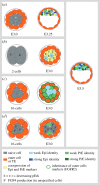Primitive endoderm differentiation: from specification to epithelium formation
- PMID: 25349446
- PMCID: PMC4216460
- DOI: 10.1098/rstb.2013.0537
Primitive endoderm differentiation: from specification to epithelium formation
Abstract
In amniotes, primitive endoderm (PrE) plays important roles not only for nutrient support but also as an inductive tissue required for embryo patterning. PrE is an epithelial monolayer that is visible shortly before embryo implantation and is one of the first three cell lineages produced by the embryo. We review here the molecular mechanisms that have been uncovered during the past 10 years on PrE and epiblast cell lineage specification within the inner cell mass of the blastocyst and on their subsequent steps of differentiation.
Keywords: blastocyst; cell differentiation; cell polarization; cell sorting; epithelium; lineage specification.
© 2014 The Author(s) Published by the Royal Society. All rights reserved.
Figures


References
Publication types
MeSH terms
Substances
LinkOut - more resources
Full Text Sources
Other Literature Sources
Miscellaneous

